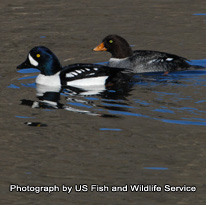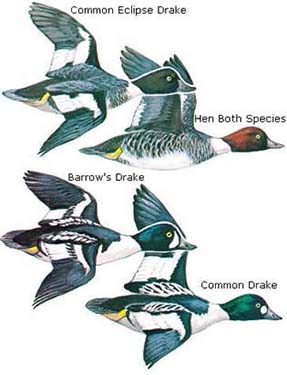Wildlife - Species

Species Specific Regulations
Goldeneye
Licenses: Hunting License required. Migratory Bird Hunting and Conservation Stamp (Federal Duck Stamp) that is validated by the hunter signing the stamp in ink across the face of the stamp
Limits: Please see Migratory Bird Regulations for any game zones restrictions or Limitations.
Common Goldeneye (Bucephala clangula)

Description
Medium sized duck recognizable by its white body, with black back and head, and oval white spot on the cheek.
Average Size
Common goldeneyes have an average length of 19 inches and an average weight of 2 1/4 pounds.
Range
Common goldeneyes are found in all four flyways. In South Carolina they are found in the Coastal Plain during the winter months.
Preferred Habitat
Goldeneyes generally move south late in the season;
most of them winter on coastal waters and the Great
Lakes. Inland, they like rapids and fast water.
Typical Flock Pattern

Wings

Food Habits
Goldeneyes consume mostly aquatic invertebrates like insects, mollusks, and crustaceans, but will also consume fish or spawn. Vegetation, such as seeds and tubers, makes up a small percentage of their diet.
Reproduction
Pair bonding likely occurs in winter to early spring. Once on the breeding grounds the female locates a suitable cavity, usually a pileated woodpecker hole or a cavity created by broken tree limbs. They will also readily use nest boxes. She then lays 5-16 glossy greenish eggs.
Sound
Drakes have a piercing speer-speer—, and hens a low quack. Both are usually quiet.
Behavior
- Goldeneyes generally move south late in the season.
- Rarely found on land or perch on tree limbs.
- Drake is territorial during the breeding season.
- Usually found in small groups of 4 to 40 individuals during the winter months.
Citations, Publications and Literature
U.S. Fish & Wildlife Service, Federal Duck Stamp Office Presents: North American Waterfowl (Adobe PDF file)
Eadie, J. M., M. L. Mallory and H. G. Lumsden. 1995. Common Goldeneye (Bucephala clangula), The Birds of North America Online (A. Poole, Ed.). Ithaca: Cornell Lab of Ornithology; Retrieved from the Birds of North America Online
South Carolina waterfowl hunters 16 and older are required by state law to obtain a state migratory waterfowl permit and Migratory Game Bird permit. Both permits must be in the hunter's possession while hunting or transporting legal waterfowl. A state waterfowl permit is included with the Lifetime Senior, Lifetime Gratis and Disability Licenses. S.C. residents who hold a Lifetime Senior or Lifetime Gratis License are not required to have a Migratory Game Bird permit.
National Migratory Bird Harvest Information Program (HIP)
The waterfowl permits and HIP permits are available from select DNR offices and from hunting and fishing license agents.
